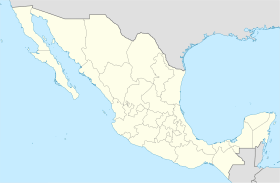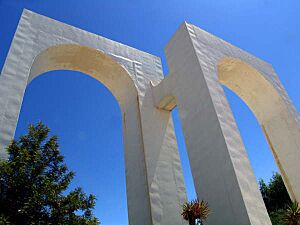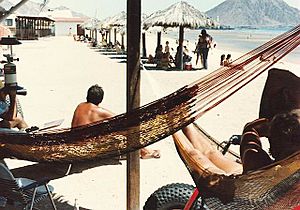San Felipe, Baja California facts for kids
Quick facts for kids
San Felipe, Baja California
Juwiy mja' (Kiliwa)
|
|
|---|---|
|
Top: Malecón de San Felipe; bottom: La Ventana del Mar (left) and Faro de San Felipe (right)
|
|
| Nickname(s):
The Gateway to the Sea of Cortés
|
|
| Country | |
| State | |
| Municipality | San Felipe |
| Founded | 1916 |
| Elevation | 9 m (30 ft) |
| Population
(2020)
|
|
| • Total | 17,143 |
| Time zone | UTC−8 (PST) |
| • Summer (DST) | UTC−7 (PDT) |
| Area code(s) | 686 |
| Website | https://san-felipemexico.com/ |
San Felipe (in Kiliwa language: Juwiy mja) is a city on the coast of Baja California, Mexico. It is located on the Gulf of California, also known as the Sea of Cortés. In 2020, about 17,143 people lived in San Felipe.
San Felipe started as a fishing town. Today, it is a popular place for tourists. People visit for its beautiful beaches, amazing nature, and exciting desert racing events. It is home to the famous San Felipe 250 race.
Contents
San Felipe's History

The first European to reach the Baja California Peninsula was Hernán Cortés in 1535. The story of San Felipe began shortly after. In September 1535, Francisco de Ulloa, one of Cortés's captains, sailed into the bay. A year later, in 1536, Hernando de Alarcón and Domingo Castillo explored the area. They made the first detailed map of the peninsula and named the San Felipe area "Santa Catalina."
Many years later, in 1701, Father Eusebio Kino rediscovered the Baja California peninsula. Then, in 1721, Juan de Ugarte built the first ship in Baja California and explored the coast, reaching San Felipe on July 5. About 25 years later, Father Ferdinand Konščak arrived and gave the bay its current name, San Felipe de Jesús.
In 1766, Wenceslaus Linck was the first European to travel to San Felipe by land. By 1794, the area was used as a port by José Joaquín de Arrillaga, who was a leader in California. He also created a land route connecting San Felipe to Ensenada.
How San Felipe Grew
San Felipe truly began to grow in 1925. This was when the first fishing camps were set up. The government also created its first local office and a school. Octavio Vega Ruiz was put in charge, and he helped San Felipe develop from 1926 to 1942.
Getting people and goods by sea also helped San Felipe become a town. Famous ships like the Trieste and Pacita helped connect the area. By the late 1920s, San Felipe had almost 100 people living there all the time. In 1940, the census showed 287 residents.
In 1947, a company bought land to build a place for international tourists. The main highway connecting Mexicali to San Felipe started being paved in 1948 and was finished in 1951. Around this time, the first hotel, Hotel Augies, opened. More hotels and motels opened in the 1950s and 1960s.
San Felipe got electricity in 1963 and running water in 1967. The 1970s brought more improvements, like government buildings, restaurants, gas stations, an airport, and a sewage system. The first four-star hotel also opened. More hotels and resorts continued to open in the following years.
Today, San Felipe's main sources of money are tourism, shrimping, and fishing. Tourism is the most important.
San Felipe's Geography
The Bay of San Felipe is about 3 meters (10 feet) above sea level. When the tide is low, the water can go back as far as 2 kilometers (1.2 miles). San Felipe has some of the biggest tides in the world. This is partly because of the Colorado River delta to the north. These large tides can show a kilometer of the ocean floor.
Valley of the Giants
The Valley of the Giants is a special natural area. It is home to very old and giant Cardon Cactus plants. Some of these cacti are thousands of years old! This valley became a big attraction after one of these huge cacti was moved to Seville, Spain, for an event in 1992.
The area is also a favorite spot for photographers from all over the world. People who care about the environment are working to protect this valley as a nature reserve. You can find the entrance to the park at 30°52′38″N 114°44′27″W / 30.8771944°N 114.7407916°W.
San Felipe's Climate
San Felipe has warm weather all year. The average temperature is about 24 °C (75 °F). San Felipe is in a unique place where the desert meets the sea. Temperatures can range from a cool 4 °C (39 °F) in winter nights to a hot 46 °C (115 °F) in the shade during July and August.
| Jan | Feb | Mar | Apr | May | Jun | Jul | Aug | Sep | Oct | Nov | Dec |
|---|---|---|---|---|---|---|---|---|---|---|---|
| 60.5 °F
15.8 °C |
60 °F
15.5 °C |
63.4 °F
17.4 °C |
68.1 °F
20 °C |
72.9 °F
22.7 °C |
78.7 °F
25.9 °C |
84.6 °F
29.2 °C |
87.3 °F
30.7 °C |
86.5 °F
30.3 °C |
80.4 °F
26.9 °C |
71.8 °F
22.1 °C |
63.8 °F
17.6 °C |
The temperature of the sea changes a lot. It can be as low as 15.5 °C (60 °F) in winter. In summer, it can reach highs of 26-30 °C (79-86 °F).
San Felipe's Economy
San Felipe is a small town. It used to rely mostly on fishing. Now, it depends a lot on tourism. Most visitors come from the United States. The city also has the San Felipe International Airport.
Fun Things to Do in San Felipe
San Felipe is a popular place for spring break for people from the western U.S. and northern Mexico. It has many fun things for tourists to do. There are nightclubs and bars along the beaches. Some visitors like to camp on the beaches. Others enjoy off-roading with ATVs and dirt bikes in the nearby desert.
Many hotels, ranches, campsites, and RV parks are in or near the town. They offer activities like volleyball, tennis, swimming pools, and fishing. In 2005, San Felipe's first golf course, Las Caras de Mexico, opened. This golf course is right by the ocean.
Exciting Off-Road Races
Another popular activity is off-road racing. Events like the Baja 250 and San Felipe 250 are held here. The Baja 250 is part of the famous Baja 1000 international race. The San Felipe 250 is hosted by CODE, an off-road racing group from Mexicali.
In 2007, the SCORE race moved to Ensenada for a short time. But the issues were fixed, and the race returned to San Felipe in 2008. CODE also holds two other races in the San Felipe Desert: the CODE San Felipe 200 in April and the CODE Race Ready 275 in December.
Other Attractions
Visitors also enjoy the hot, sulfurous springs at Puertecitos. These natural springs are on the Sea of Cortez. The sea water helps to cool them down a bit.
In recent years, San Felipe has started celebrating Carnaval. It's sometimes called a Mexican Mardi Gras. While it's smaller than other Mexican carnivals, it's a fun event for locals and tourists.
A newer event in San Felipe is the International Blues & Arts Fiesta. This event is held on the last Saturday in March. It helps raise money for the San Felipe Lions Club.
Every two years, San Felipe welcomes hundreds of motorcycles for the Devils Run festival. This event happens on the last weekend of April. Many riders come from Temecula, California, but bikers travel from all over. The three-day event includes contests and gatherings, like a rock concert. It fills up almost all the hotels in town.
One less-known trip in San Felipe is a boat ride to Konsag Island. This is a large rock that you can see from the San Felipe coast. It's about an hour out to sea. The waters around the rock are full of marine life, making it a great spot for fishing.
See also
 In Spanish: San Felipe (Baja California) para niños
In Spanish: San Felipe (Baja California) para niños









